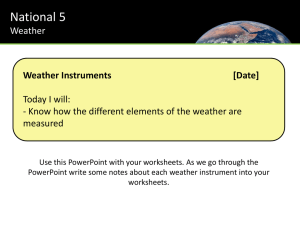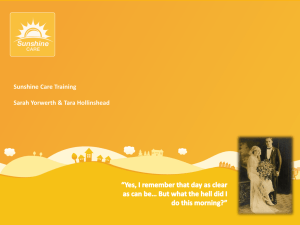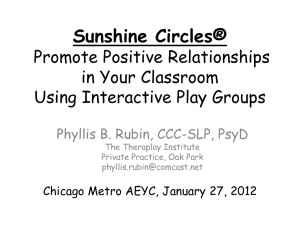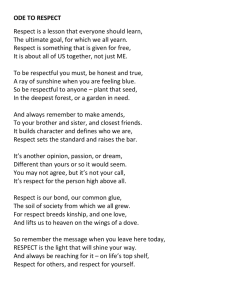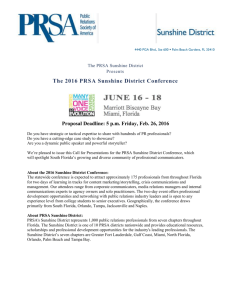presentation VTHC HSR 2015
advertisement
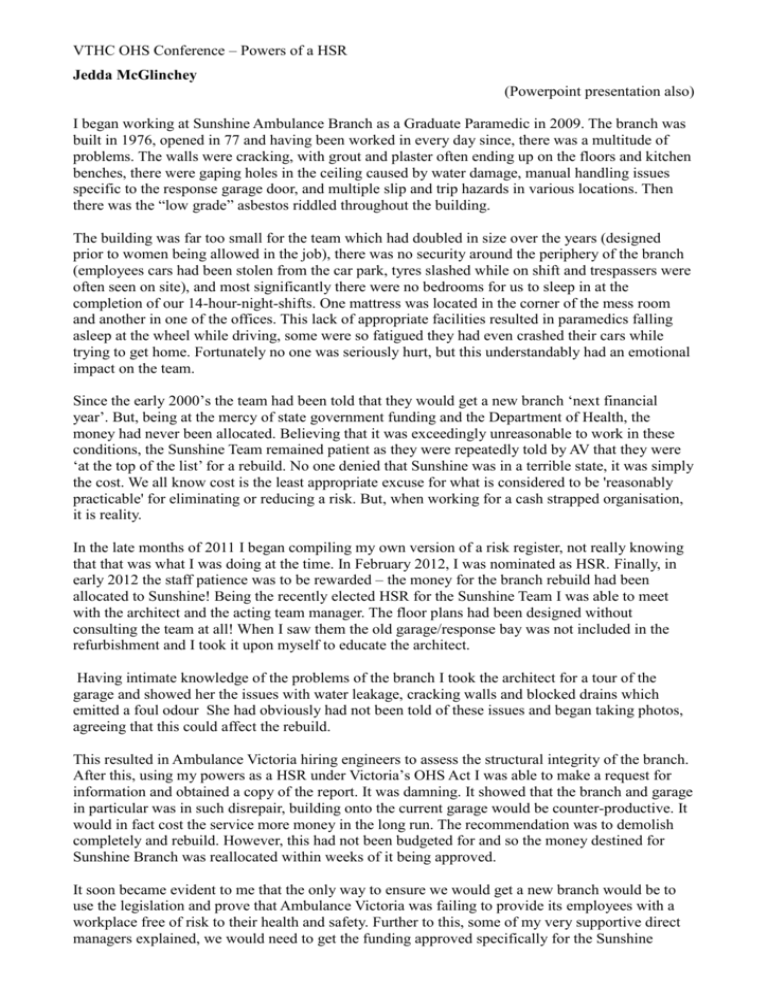
VTHC OHS Conference – Powers of a HSR Jedda McGlinchey (Powerpoint presentation also) I began working at Sunshine Ambulance Branch as a Graduate Paramedic in 2009. The branch was built in 1976, opened in 77 and having been worked in every day since, there was a multitude of problems. The walls were cracking, with grout and plaster often ending up on the floors and kitchen benches, there were gaping holes in the ceiling caused by water damage, manual handling issues specific to the response garage door, and multiple slip and trip hazards in various locations. Then there was the “low grade” asbestos riddled throughout the building. The building was far too small for the team which had doubled in size over the years (designed prior to women being allowed in the job), there was no security around the periphery of the branch (employees cars had been stolen from the car park, tyres slashed while on shift and trespassers were often seen on site), and most significantly there were no bedrooms for us to sleep in at the completion of our 14-hour-night-shifts. One mattress was located in the corner of the mess room and another in one of the offices. This lack of appropriate facilities resulted in paramedics falling asleep at the wheel while driving, some were so fatigued they had even crashed their cars while trying to get home. Fortunately no one was seriously hurt, but this understandably had an emotional impact on the team. Since the early 2000’s the team had been told that they would get a new branch ‘next financial year’. But, being at the mercy of state government funding and the Department of Health, the money had never been allocated. Believing that it was exceedingly unreasonable to work in these conditions, the Sunshine Team remained patient as they were repeatedly told by AV that they were ‘at the top of the list’ for a rebuild. No one denied that Sunshine was in a terrible state, it was simply the cost. We all know cost is the least appropriate excuse for what is considered to be 'reasonably practicable' for eliminating or reducing a risk. But, when working for a cash strapped organisation, it is reality. In the late months of 2011 I began compiling my own version of a risk register, not really knowing that that was what I was doing at the time. In February 2012, I was nominated as HSR. Finally, in early 2012 the staff patience was to be rewarded – the money for the branch rebuild had been allocated to Sunshine! Being the recently elected HSR for the Sunshine Team I was able to meet with the architect and the acting team manager. The floor plans had been designed without consulting the team at all! When I saw them the old garage/response bay was not included in the refurbishment and I took it upon myself to educate the architect. Having intimate knowledge of the problems of the branch I took the architect for a tour of the garage and showed her the issues with water leakage, cracking walls and blocked drains which emitted a foul odour She had obviously had not been told of these issues and began taking photos, agreeing that this could affect the rebuild. This resulted in Ambulance Victoria hiring engineers to assess the structural integrity of the branch. After this, using my powers as a HSR under Victoria’s OHS Act I was able to make a request for information and obtained a copy of the report. It was damning. It showed that the branch and garage in particular was in such disrepair, building onto the current garage would be counter-productive. It would in fact cost the service more money in the long run. The recommendation was to demolish completely and rebuild. However, this had not been budgeted for and so the money destined for Sunshine Branch was reallocated within weeks of it being approved. It soon became evident to me that the only way to ensure we would get a new branch would be to use the legislation and prove that Ambulance Victoria was failing to provide its employees with a workplace free of risk to their health and safety. Further to this, some of my very supportive direct managers explained, we would need to get the funding approved specifically for the Sunshine VTHC OHS Conference – Powers of a HSR rebuild, so that the money could not be reallocated again. Over the next few months I compiled all available evidence of consultation between the Sunshine team members and upper management regarding the branch, as a HSR I was able to access this information. This meant trawling through old documents, Hazard and Incident Reports, emails, old branch inspections and I continued to expand the risk register. I read through internal AV documents, Work Safe compliance codes and other publications to expand my knowledge. Most of the issues had been logged multiple times but continued to get worse. Some of the documentation I found regarding the sleeping quarters and security was as old as 2002 and in fact contravened AVs own 'branch design guidelines'. Around June I completed the HSR training course with the Victorian Trades Hall Council with the sole purpose of learning how to write a PIN. With the help of the AEA (my union) and Trades Hall, in July 2012 I issued Ambulance Victoria with three PIN’s. They were each rather broad but essentially were; 1) Failure to maintain the workplace, 2) Failure to provide adequate fire safety preparedness and 3) Failure to provide essential facilities (being bedrooms). Ambulance Victoria asked for a Work Safe Victoria inspector to assess the property and meet with all parties concerned, as AV disputed the PINs. The Work Safe Inspector wrote eight Improvement Notices himself, specific to each issue (windows, manual handling of the doors, drain, trip hazards, temperature control, bedrooms and security) and delivered them to AV, giving them a month to comply. At the next meeting Ambulance Victoria, having no readily available finances, successfully argued that they would need more time to obtain funding. This resulted in the inspector granting them an additional three months to comply with the notices. At this time utterly frustrated I went against AV policy and contacted the local media, who were very interested in the story. While, in hindsight, this was not the most tactful decision for my career, I was desperate and it was very reassuring to hear that the issues were newsworthy. This even caught the attention of my local member, who at the time, was the Secretary to the Shadow Minister of Health. The issues at Sunshine were starting to gain some momentum, both within the service and publicly. While, in hindsight, this was not the most tactful decision for my career, I was desperate and it was very reassuring to hear that the issues were newsworthy and the public support was greatly needed. Being a very small industry, and through the union, most of the service knew that the issues at Sunshine were starting to gain some momentum. Some of the more cosmetic issues were fixed within those three months. Ceilings were patched, trip hazards removed and painting completed. Nevertheless, the two highest risk hazards - lack of sleeping facilities and nil security remained neglected. Ambulance Victoria applied for and was permitted even more extensions for these. I requested for Work Safe to complete an internal review with a senior and impartial inspector, as I contested the decision, but the extensions were upheld. AV and Work Safe negotiated and tried to instigate interim control measures, which in my opinion were grossly insufficient. During this time I was spoken to by management who tried to influence me by saying that fixing these issues now, when we were going to get a new branch anyway was putting my colleagues at a disservice because the money would be taken away from other projects. I replied that if they had maintained the premises appropriately, as is their responsibility under the act, we would not be having this conversation. If they hadn't tried the patience of the Sunshine team over the last ten years, perhaps we would have been a little more obliging. Throughout this time I made sure to inform the team of any progress made, what stage in the process we were and what my next action was going to be. When you feel like you’re being beaten into submission by frustration and bureaucracy it’s easy to feel like you're not progressing. It's so important to update and inform your DWG just so they know that you haven't forgotten but so that VTHC OHS Conference – Powers of a HSR they feel empowered with the knowledge of what's happening in their workplace. I followed AV's issue resolution process and OHS policies to the letter, which allowed the process and paper trail to be almost impenetrable. I asked other HSRs within the service their experiences, called the union and trades hall many times and tried to use every resource available to me. I took the time to anticipate AV's reaction and what they would say, so that I could prepare a counter argument, but it wasn't enough. By January 2013 I had exhausted all options, having followed the issue resolution procedure to its limit, I called a team meeting and explained that I felt that I needed to issue a cease work. They agreed. The team stated that they would support me and voted to take unprotected industrial action if the cease work was disputed by AV. AV did not appreciate me issuing the Cease Work. Management were hurriedly speaking with HR and the communications centre was telling all crews in the area to keep well away from the branch. The Sunshine crews that were out on cases were called directly on their personal phones and warned about the ramifications of refusing to return to the Sunshine Branch between cases, even though I had issued the cease work, that it was unprotected industrial action and that there would be consequences. Nevertheless the team stuck together and walked out, to a round of applause from the hundred or so Paramedics who gathered out front of the branch to support them. AV called an urgent meeting with the inspector and myself. Spurred on by the support of my DGW and colleagues I stood my ground and reiterated that we needed a new branch, not band-aids and interim solutions. The only way that we were going to fix the problems was to get a new branch. AV finally agreed that their suggested controls were inadequate and they would obtain funding for a full rebuild. On this proviso (assisted by the media getting some handy quotes from management) the team agreed to continue to work out of Sunshine and I retracted the cease work, on the requisite that progress would be imminent. AV management knew if the team felt it was necessary they would not hesitate to walk off again and I would reissue a cease work. By March 2013 the team was finally told the funding had been approved and was unable to be reallocated, it had been specifically designated to the project of rebuilding Sunshine. By mid-year, alternative premises were found and the Sunshine Team moved into a temporary home, just down the road in Braybrook. In December 2013 the old branch was demolished and is now in the process of being rebuilt. Although it is over a year behind schedule, we're due to move in by Christmas this year. *** While I always focused on the welfare of my colleagues I had to take into account the reality of the resource capabilities and finances of AV. Ultimately, it was this sense of reason that made reaching an agreement possible. I have since been told by upper management, that although I was clearly incensed, my ability to remain (somewhat) diplomatic, understanding and cooperative was very beneficial to the cause. That, and apart from going to the local newspaper, everything I did followed procedures and policy to the fullest extent. That being said, even though I used the OHS legislation to the best of my abilities, if my DWG hadn't supported me 100% and I didn't have the encouragement of my union and colleagues, things could have turned out very differently. It is not enough to be reactive, otherwise you get situations of chronic neglect like the Sunshine Branch. We need to be proactive and revisit current practices to ensure we are really mitigating the risks in the most appropriate way. We need to have foresight to anticipate how things are going to be used now, and in the future. Management will have an idea, but the only people who will have the true knowledge are the workers. We need to look out for ourselves and our colleagues. This is why having a support network, an VTHC OHS Conference – Powers of a HSR approachable HSR, an advocate, is so important. Some say that upper management is disconnected with the coal face, creating difficulties with communicating issues up the hierarchy. The HSR is the conduit between the workforce and management, and a good rep knows that they have the responsibility not to sit idly but to challenge. My advice would be to stay persistent and try to not let it get you down, you can succeed.
